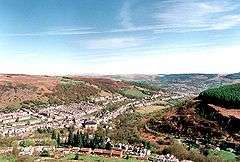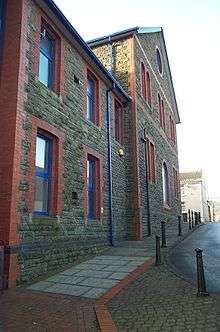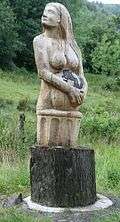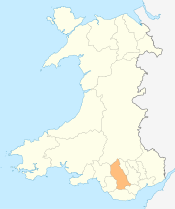Cwmaman
| Cwmaman | |
| Welsh: Cwmaman | |
 |
|
 Cwmaman |
|
| Population | 1,000 |
|---|---|
| Principal area | Rhondda Cynon Taf |
| Ceremonial county | Mid Glamorgan |
| Country | Wales |
| Sovereign state | United Kingdom |
| Dialling code | 01685 |
| Police | South Wales |
| Fire | South Wales |
| Ambulance | Welsh |
| EU Parliament | Wales |
| UK Parliament | Cynon Valley |
|
|
Coordinates: 51°41′00″N 3°26′00″W / 51.6833°N 3.4333°W
Cwmaman (Welsh pronunciation: [kʊmˈaman]) is a former coal mining village near Aberdare, Wales. The name Cwmaman is Welsh for "Aman Valley", with the River Aman flowing through the village). For postal purposes the village comes under Aberdare. The village lies in the valley of several mountains. Within the village, there are two children's playgrounds and playing fields, with an outdoor pool open during the summer. At the top end of the village, there are several reservoirs, accessible via several footpaths along the river.
History
Cwmaman was a well-known coal-mining village which, at one time boasted several collieries. Until the 19th Century, Cwmaman was virtually uninhabited, with around 40 farm workers living in and around the community by 1841. By the end of the 1840s, the first coal pits were sunk and Cwmaman began to transform into a thriving industrial settlement, in the later years of the 19th century Cwmaman housed the workers of five surrounding coal mines - the Fforchaman, Fforchneol, Bedwlwyn, Cwmneol, and the Cwmaman. Cwmaman Colliery was also known as Shepherd’s Pit, in honour of its founder Thomas Shepherd, a name it shares with the village’s first public house, the Shepherd’s Arms, which was opened in 1850.
There is an array of parallel roads in the east part of the village. Burns Street and Spencer Street, along with the other streets collectively known as Poets' Corner, are amongst the steepest in the United Kingdom.
Culture

The band Stereophonics comes from Cwmaman. On 14 December 2007, in association with Jo Whiley and her BBC Radio 1 Live Lounge Tour, the Stereophonics returned to Cwmaman to play an exclusive acoustic gig in the Cwmaman Working Men's Club, the venue where the band first performed.
The village is home to the war poet Alun Lewis, and a plaque in what is now Llanwonno Road marks the house where he once lived. Born in 1915 in the village’s Llanwonno Road, Lewis was strongly influenced by his formative years in the depression-era valley. He was also influenced by local issues of his community in the then-called Aberdare Leader and this is proved in his great poem The Mountain over Aberdare, which touches on the desperate poverty that beset the Cynon Valley and the country in this period. However, it was for his war poems, published in two volumes (Raiders Dawn and Ha! Ha! Among the Trumpets) that Alun Lewis’s reputation would be made. His name lives on, both as a significant poet and within the village itself, not only in a plaque commemorating the house of his birth, but also in the name of the village’s Cwrt Alun Lewis flats.
Cwmaman Public Hall & Institute is a community-owned enterprise: it consists of a concert room, theatre / cinema and fitness suite
St. Joseph's Church was renovated in 2007. This work included the installation of solar panels on one side of its roof with the aim to sell back energy to the National Grid.
The Cwmaman Music Festival is held at the last weekend of September every year. It started in 2008 and has attracted artists such as Alabama 3, Mike Peters, Killing for Company and many unsigned artists of all genres.
Religion
Although difficult to appreciate today, religion played a central role in the life of the village until the second half off the twentieth century. Seion, Cwmaman remained an active place of worship until its closure for financial reasons in 2013. The congregation still meets at the former Moriah Aman Congregational Chapel, now an evangelical church. The third Welsh language chapel in the village was Soar, a Calvinistic Methodist church which closed in the late 1980s. It has now been demolished.
Cwmaman was particularly affected by the Religious Revival of 1904-05 which had an impact throughout the Cynon Valley. In January 1905 it was reported that meetings were being held every evening at the various chapels and a number of secular organisations had abandoned their meetings for the time being.[1] Later that month, another report stated that out-door meetings were being held in relation to the revival, and that prayer meetings were being held in the mornings at Cwmaman Colliery. [2]
Regeneration and the community

Cwmaman is a Communities First area, officially recognised as needing Welsh Assembly support to assist the community solve problems of social disadvantage.
The Cwmaman Communities First Partnership was established in October 2001 aiming to bring individuals, voluntary groups and public and private sector organisations in the community together to help create a better future for the area.[3]
Many innovative environmental projects have taken place including the hosting of an environmental festival centred on St Joseph's Church, holding a sculpture exhibition, the development of a community woodland walk, and establishing a Cwmaman Sculpture Trail.
A range of sculptors have contributed to projects in the village, including Robert Koenig, Dai Edwards, Tom Harvey, Godfrey Phillips, Paul Clarke, Dave Lloyd, Dominic Claire and Peter Boyd.
Community Archives Wales
The St Joseph's Heritage Group, based in St Joseph's Church joined the Community Archives Wales project in 2007. Cwmaman Institute is at the heart of its community, demonstrated by the range of groups and societies that it accommodates, housing over 40 societies. The history and culture of Cwmaman are unique and the community is desperate to share their stories with the world online. With a brand new digi-lab at St Joseph's Church, which will also employ a part-time IT worker, it is training and expertise that the group urgently needs, and will attain through participating in the Community Archives Wales project.
Politics
Cwmaman was a traditional Labour Party stronghold, although in more recent times it has been challenged by Plaid Cymru. It lies in the Aberaman South electoral ward, currently represented by Councillor Tina Williams (Labour).
Notable people
- Kelly Jones - lead singer with rock band Stereophonics
- Stuart Cable (1970–2010) - broadcaster and Stereophonics drummer
- Richard Jones - Stereophonics bassist
- Alun Lewis - poet
- Tyrone O'Sullivan - Chairman of Tower Colliery lived in Cwmaman for many years
- Ron Jones - sprinter
References
- ↑ "The Revival". Aberdare Leader. 7 January 1905. p. 8. Retrieved 10 November 2016.
- ↑ "The Revival". Aberdare Leader. 28 January 1905. p. 7. Retrieved 10 November 2016.
- ↑ "The Communities First Partnership". cwmaman-regeneration.org.uk/. 2004. Retrieved 31 January 2012.
External links
- Community Archives Wales
- Cwmaman Public Hall & Institute
- St Joseph's Church (Church in Wales) Cwmaman
- www.geograph.co.uk : photos of Cwmaman and surrounding area
- Cwmaman Music Festival
